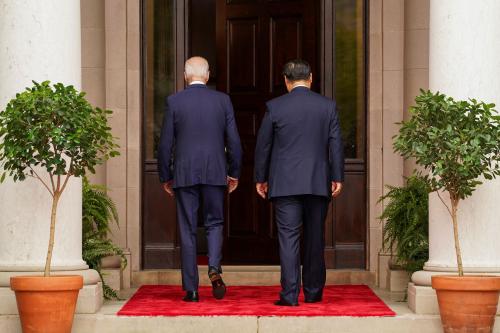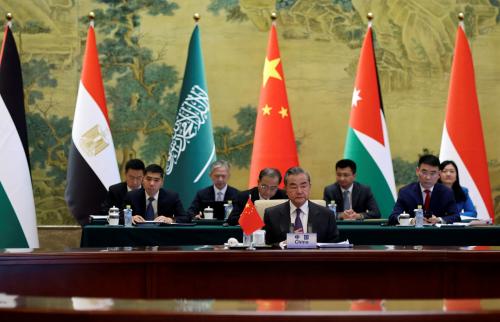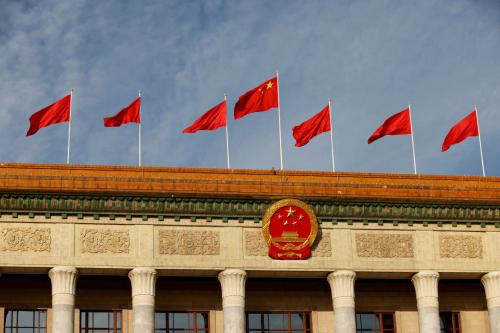This is the third essay of Global China’s “Lost in translation: Decoding Chinese strategic narratives” series. The full collection of essays can be found here.
In October 2022, Chinese Communist Party (CCP) General Secretary Xi Jinping raised eyebrows with his pledge at the 20th Party Congress to “create a strong strategic deterrent force system” (打造强大战略威慑力量体系). The line evoked China’s massive nuclear buildup, the contours of which were by then beginning to become clear. It also came less than a year after Russian President Vladimir Putin summoned his own “strategic deterrence” forces to keep NATO at arm’s length in Ukraine and amid rumors that China might soon attack Taiwan. Xi’s comments were not a throwaway line, since the CCP’s 14th Five-Year Plan, released in March 2021, similarly called on the People’s Liberation Army (PLA) to “build a high-level strategic deterrent and joint operations system” (打造高水平战略威慑和联合作战体系). Yet neither Xi nor other Chinese officials elaborated on the phrase. What were Xi’s intentions and what can the answers tell us about Chinese thinking on deterrence?
Evidence from PLA sources before and after the 20th Party Congress suggests three possible interpretations. First is that Xi was mainly referring to the need to improve China’s deterrence against what he perceived as a more aggressive U.S. antagonist. Second is that he was encouraging a broader idea of tailored coercion (and not “deterrence” in the classic sense) focused on using an array of military instruments to shape the regional security environment in China’s favor. Third is that “strategic deterrence” was a reference to Xi’s support for greater status and resourcing for the PLA Rocket Force, which was the “core force” in China’s expanding nuclear arsenal. Without being inside Xi’s mind, it is difficult to know which interpretation is closest to the truth. But each one illuminates key issues facing the PLA as it seeks to build and employ more credible deterrent forces.
Shield: Responding to perceived U.S. threats
The first interpretation views the “strategic deterrent force system” as a response to upgrades in the U.S. strategic arsenal and Chinese concerns about U.S. intervention in Taiwan. Some discussions within the People’s Republic of China (PRC) filter “strategic deterrence” through the lens of maintaining the strategic balance between the nuclear powers. Twenty years before Xi’s comments, in February 2002, Jiang Zemin delivered a similar injunction to build a “strategic deterrence system” but provided a fuller rationale based on changes in the international strategic environment. Speaking at an enlarged meeting of the Central Military Commission, Jiang stated:
“Strategic deterrence has already become an important feature of the current international military struggle. The United States, Russia, the United Kingdom and France all place nuclear weapons as the core forces of their strategic deterrent. The U.S. has a ‘triad’ strategic deterrent, including nuclear and non-nuclear strike systems, active and passive defense systems, and national defense basic infrastructure; its core thought is the application of strategic deterrent means … We must base ourselves on the existing situation, focus on development, and gradually form a strategic deterrence system that combines multiple means.”
PLA analysts also discussed how the nuclear powers were adjusting their own strategic deterrents. Zhang Yan, a PLA National Defense University scholar, traced the historical evolution of the “strategic deterrent” concept from 1945 through the post-Cold War period, arguing that beginning in the 1990s, “information deterrence, space deterrence, and cyber deterrence play an increasingly important role. Strategic deterrence theory continues to develop into a system.” Into the 21st century, other PLA writings analyzed “strategic deterrent systems” through discussions of upgraded U.S. nuclear and non-nuclear deterrent capabilities, including ballistic missile defenses, global conventional strike, and anti-satellite weapons (see here, here, and here). Scholars also assessed changes in Russian strategic forces, including the rise of long-range hypersonic missiles.
PRC strategists were increasingly concerned that upgrades to U.S. systems in particular could undermine China’s nuclear deterrent. According to research from Henrik Hiim, M. Taylor Fravel, and Magnus Trøan, specific challenges included advances in U.S. missile defense capabilities, the U.S. withdrawal from the Intermediate-Range Nuclear Forces Treaty in 2019, and enhancements to U.S. conventional global strike forces. These perceptions, in their analysis, can help explain the nuclear expansion and diversification that Xi may have been referencing in his 2022 comments.
Other discussions contend that strategic deterrence upgrades are needed not only to maintain survivable nuclear forces but also due to PRC perceptions of a hostile turn in U.S. policies toward China under the Trump and Biden administrations, and in particular the possibility that the PLA would need to bolster its ability to deter U.S. military intervention in a Taiwan conflict. In a 2022 article for the CCP journal People’s Tribune, Ge Tengfei, a scholar at the National University of Defense Technology, describes strategic deterrence as the “final, decisive, and reliable strategic military force … in the strategic military struggle against hegemony and bullying.” He specifically notes that the “strong strategic deterrent force system” is a:
“Trump card for safeguarding the country’s core interests. This is also a clear and unequivocal message to external interfering forces not to underestimate the Chinese people’s strong determination, firm will, and strong ability to defend national sovereignty and territorial integrity. Any external interference will inevitably be met with a resolute counterattack by the Chinese people. Any external interference will not succeed.”
Ge’s analysis followed a number of articles assessing the role that Russian strategic capabilities played in limiting NATO intervention in Ukraine. Philip Saunders and David Logan argue that China’s nuclear expansion could provide a “nuclear shield” by countering U.S. nuclear intimidation and potentially deterring conventional intervention as well, giving the PLA more “freedom of action” in a Taiwan crisis. The 2023 China Military Power Report authored by the Office of the Secretary of Defense reached a similar conclusion, arguing that “the PRC’s pursuit of a ‘strong strategic deterrent force system’ is probably driven by threat perceptions of the United States and by specific concerns over Taiwan.”
Sword: Shaping the security environment
A second interpretation is that Xi was referencing the broader idea that China should effectively use forces across all domains to shape the security environment. The premise of this argument is that “strategic deterrence” (战略威慑) is a mistranslation of a concept that includes elements, in Thomas Schelling’s terminology, of both “deterrence” and “compellence.” The “Science of Military Strategy,” a key textbook first published in 2001 and used in China’s military educational system, notes that “strategic deterrence” not only seeks to “dissuade the opponent from doing something,” but also to “persuade the opponent what ought to be done”; “both demand the opponent to submit to the deterrer’s volition.” The term is thus perhaps better translated as “strategic coercion.”
Multiple editions of “The Science of Military Strategy,” including the 2001 version (published by the Academy of Military Sciences) and the 2020 version (published by the PLA National Defense University) outline five categories of “strategic coercion” tools: nuclear, space, information, conventional, and “People’s War,” referring to popular willpower and the ability to mobilize civilian resources for major campaigns. (For further discussion, see analyses by Dennis Blasko, Dean Cheng, and Michael Chase and Arthur Chan). In essence, every military instrument available to the Chinese Communist Party has potential coercive utility, not only in influencing U.S. decisions but also those of China’s territorial rivals through the calibrated and creative application of armed force.
Chinese texts elucidate several ways in which these capabilities can be used to shape adversary decisions. The 2004 classified book “Science of Second Artillery Campaigns” and other PLA writings described various ways in which nuclear forces could be displayed in a crisis scenario, such as raising nuclear alert levels or conducting snap exercises.1 These tools would be consistent with the “nuclear shield” model outlined above. Other uses, however, are more applicable to day-to-day operations and minor clashes. The 2020 “Science of Military Strategy” noted that displays of advanced weapons, military exercises, and information attacks could all be employed against opponents in the context of “strategic coercion.” Notably, all of these tools were used in August 2022 in the wake of then-Speaker of the House Nancy Pelosi’s visit to Taiwan.
Another option presented in the 2020 “Science of Military Strategy” chapter on “strategic deterrence” highlighted “interference in the other party’s routine military activities, actions near the other party’s air and sea lines of communications, and threatening the safety of its airways and waterways.” These activities, which the authors label “restrictive military operations,” align with other recent uses of armed force, including using Coast Guard ships to block the entrances to Second Thomas Shoal, where China is locked in a standoff with the Philippines, which most recently prompted the Filipino foreign minister to issue a demarche complaining that Chinese ships had “harassed and blocked“ lawful maritime operations. In a new turn of events, China Coast Guard ships have also begun to conduct patrols close to Taiwan-held Kinmen Island and have boarded a Taiwanese ship. The options to increase a “strong system” of “strategic coercion,” in this interpretation, are facilitated by China’s expanding conventional air and naval forces, as well as the CCP’s greater risk-taking in regional disputes under Xi.
Symbol: Bestowing status on the Rocket Force
A final interpretation is that Xi’s 2022 comments were more bureaucratically focused, useful primarily for signaling his priority attention on the PLA Rocket Force. The starting point for this argument is that statements from top party officials in events such as the 20th Party Congress can signal leadership preferences for the allocation of resources and attention among the bureaucracy. In previous speeches, Xi indicated favorites through subtle messaging, as in 2014 when he referred to the air force as a “strategic service” (战略军种), confirming its identity as a modernizing force with new roles and missions—and one that was spared the budget axe when Xi downsized the PLA beginning in late 2015. In 2016, he described the new Strategic Support Force, responsible for space and cyber operations, as an “important support for the military’s joint operations system.”
Xi has used the discourse of “strategic deterrence” in previous references to the Rocket Force. In January 2016, when he announced the upgrading of the former Second Artillery into a full service known as the Rocket Force, he described the new entity as the “core force for strategic deterrence” (火箭军是战略威慑核心力量). In September 2016, during a visit to Rocket Force headquarters, he used the same formulation and added that the service was the “strategic support for China’s status as a great power and an important cornerstone for safeguarding national security.”
Xi’s 2022 address also complemented how the Rocket Force was speaking about its own status. Commentary at a 2015 military parade to mark the 70th anniversary of the end of World War II lavished attention on the newly-revealed DF-26 intermediate-range missile, described as “a new weapon on our military’s strategic deterrent system.” After the 20th Party Congress, PLA Daily quoted grassroots personnel from the Rocket Force saying that Xi’s comments about building a “strong strategic deterrent force system” “impressed me deeply,” adding that their brigade is responsible for “a national treasure of the country.” A December 2023 PLA Daily report on Rocket Force training likewise linked Xi’s party congress statement with the service’s mission to supply “powerful weapons” that are needed to secure a “reliable and effective deterrent.” Such comments arguably justified the heavy spending needed to develop and expand the Rocket Force’s arsenal.
Interestingly, albeit tangentially, another group in the PLA also appropriated Xi’s comments to justify its own status. On at least two occasions, officials from the PLA’s mobilization system—which plays a role in the more broadly defined version of “strategic deterrence” by handling “People’s War”—have referenced Xi’s party congress statement. At the 14th National People’s Congress in March 2023, a representative from the Guangxi Military District claimed that mobilization and reserve forces “are a solid backing to support victory and have a strategic deterrent function.” In August 2023, an official from the Shandong Military District argued that “national defense mobilization is an important measure to build a strong strategic deterrent force system.” Xi might have had the Rocket Force in mind, but this did not stop others from linking their own raison d’etre to Xi’s invocations.
Implications of a stronger “strategic deterrent force system”
Evaluating which interpretation is closest to Xi’s meaning is difficult because Xi, unlike Jiang twenty years earlier, did not elaborate. Unhelpfully, a compendium of definitions of key terms used at the 20th Party Congress published on the PLA’s official website offered this explanation of a “strong system of strategic deterrent forces”:
“We must comprehensively strengthen military training and preparations, improve the people’s army’s ability to win, innovate military strategic guidelines, develop People’s War strategies and tactics, build a strong strategic deterrent system, increase the proportion of new-domain and new-quality combat forces, and further promote actual combat-oriented military training.”
Based on this meandering definition, the authors probably lacked insight into Xi’s intentions or the ways in which “strategic deterrent forces” would support the 14th Five-Year Plan.
Nevertheless, the three lenses that might be affixed to Xi’s comments help to illuminate how the PLA is developing credible deterrent forces, and the challenges it faces. As a “shield,” the PLA has undergone a rapid expansion and diversification of its nuclear and strategic non-nuclear forces, such as space and cyber weapons, likely with the task of deterring U.S. intervention in a Taiwan crisis in mind. This buildup is likely to continue even as anti-corruption investigations continue; the Department of Defense estimates that by 2030 China will have fielded 1,000 operational nuclear warheads (double today’s figure). Yet these developments have also led the U.S. Department of Defense to consider new doctrine and capabilities designed to promote operations in a contested environment. China’s developments have also instigated the United States and others to refine their own strategic capabilities, exemplified by the focus in AUKUS—an acronym for the trilateral partnership between Australia, the U.K., and the United States—on building hypersonic and counter-hypersonic systems, and Japan’s emphasis on counterstrike weapons.
As a sword that might be used to shape an adversary’s decisions, China’s “strategic coercion” has been on display in regional contests. Recent flare-ups with the Philippines and Taiwan showcase how a larger set of military and paramilitary capabilities has been instrumental in China’s quest for effective control of disputed regions. A 7.2 percent increase in China’s military budget approved at the March 2024 National People’s Congress suggests that funding will be available to expand China’s regional advantage in the air and maritime capabilities needed for these operations, and to fund maintenance and current operations. Yet strategic pressure has resulted in worsening public opinion of China in many countries and has prompted some of them to upgrade their own forces, sometimes in concert with the United States. This was evident in the Duterte administration’s decision to retain a U.S. rotational presence in the Philippines, and the Marcos administration’s granting of additional basing and access to U.S. forces. “Strategic coercion” has thus undermined a focus of PRC grand strategy: to drive wedges between Washington and its allies.
Finally, as a symbol of Xi’s bureaucratic preferences, the Rocket Force has acquired the funding it needs to become a “core force” of the “strategic deterrent force system” through modernized nuclear and conventional systems. However, recent suspicions of widespread corruption within the Rocket Force’s leadership—including Xi’s purges of its commander and political commissar, and their replacement by officers pulled in from the navy and air force—suggested poor oversight of the massive spending circulating through the procurement system. Such scandals could give Xi pause if he questions not only the competence and professionalism of the officers that he himself appointed into sensitive operational roles but especially if he comes to doubt the reliability of the missile forces and other key equipment purchased over the last decade.
In sum, Xi’s lofty rhetoric on “strategic deterrence” at the 20th Party Congress illuminates China’s impressive progress in fielding strategic capabilities, but also the tit-for-tat U.S. responses, regional pushback, and internal mismanagement that have complicated the buildup.
-
Acknowledgements and disclosures
The views in this article represent only those of the author, and not the National Defense University, the Department of Defense, or the U.S. government.
-
Footnotes
- You can see pages 28-31 of this 2017 RAND study for more details, https://www.rand.org/pubs/research_reports/RR1628.html.







Commentary
Shield, sword, or symbol: Analyzing Xi Jinping’s “strategic deterrence”
March 7, 2024